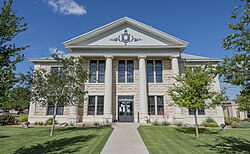Demographics
Historical population| Census | Pop. | Note | %± |
|---|
| 1890 | 208 | | — |
|---|
| 1900 | 286 | | 37.5% |
|---|
| 1910 | 1,143 | | 299.7% |
|---|
| 1920 | 555 | | −51.4% |
|---|
| 1930 | 1,263 | | 127.6% |
|---|
| 1940 | 1,193 | | −5.5% |
|---|
| 1950 | 1,089 | | −8.7% |
|---|
| 1960 | 1,118 | | 2.7% |
|---|
| 1970 | 1,155 | | 3.3% |
|---|
| 1980 | 1,304 | | 12.9% |
|---|
| 1990 | 1,447 | | 11.0% |
|---|
| 2000 | 1,406 | | −2.8% |
|---|
| 2010 | 1,226 | | −12.8% |
|---|
| 2020 | 1,116 | | −9.0% |
|---|
| 2024 (est.) | 1,153 | [7] | 3.3% |
|---|
|
Glasscock County, Texas – Racial and ethnic composition
Note: the US Census treats Hispanic/Latino as an ethnic category. This table excludes Latinos from the racial categories and assigns them to a separate category. Hispanics/Latinos may be of any race.| Race / Ethnicity (NH = Non-Hispanic) | Pop 2000 [12] | Pop 2010 [10] | Pop 2020 [11] | % 2000 | % 2010 | % 2020 |
|---|
| White alone (NH) | 955 | 825 | 710 | 68.92% | 67.29% | 63.62% |
| Black or African American alone (NH) | 6 | 15 | 8 | 0.43% | 1.22% | 0.72% |
| Native American or Alaska Native alone (NH) | 1 | 3 | 0 | 0.07% | 0.24% | 0.00% |
| Asian alone (NH) | 0 | 1 | 0 | 0.00% | 0.08% | 0.00% |
| Pacific Islander alone (NH) | 0 | 2 | 3 | 0.00% | 0.16% | 0.27% |
| Other Race alone (NH) | 0 | 0 | 0 | 0.00% | 0.00% | 0.00% |
| Mixed Race or Multiracial (NH) | 24 | 2 | 8 | 1.71% | 0.16% | 0.72% |
| Hispanic or Latino (any race) | 420 | 378 | 387 | 29.87% | 30.83% | 34.68% |
| Total | 1,406 | 1,226 | 1,116 | 100.00% | 100.00% | 100.00% |
At the 2000 census there were 1,406 people, 483 households, and 355 families in the county. The population density was 2 people per square mile (0.77 people/km2). There were 660 housing units at an average density of 1 units per square mile (0.39 units/km2). The racial makeup of the county was 77.52% White, 0.50% Black or African American, 0.14% Native American, 0.21% Pacific Islander, 19.13% from other races, and 2.49% from two or more races. 29.87% of the population were Hispanic or Latino of any race. [13] Of the 483 households 42.00% had children under the age of 18 living with them, 67.50% were married couples living together, 2.90% had a female householder with no husband present, and 26.50% were non-families. 23.80% of households were one person and 7.00% were one person aged 65 or older. The average household size was 2.91 and the average family size was 3.51.
The age distribution was 33.50% under the age of 18, 7.10% from 18 to 24, 28.40% from 25 to 44, 22.00% from 45 to 64, and 9.00% 65 or older. The median age was 34 years. For every 100 females there were 108.90 males. For every 100 females age 18 and over, there were 113.00 males.
The median household income was $35,655 and the median family income was $43,000. Males had a median income of $27,000 versus $27,083 for females. The per capita income for the county was $18,279. 14.70% of the population and 11.50% of families were below the poverty line. Out of the total people living in poverty, 17.50% are under the age of 18 and 4.10% are 65 or older.
Politics
West Texas is one of the most strongly conservative areas of the nation, and Glasscock County is heavily Republican. The only time since 1948 it supported a Democrat for president was 1960. In the last eight elections, fewer than 100 voters have supported the Democratic candidate, and in the last seven elections, the Republican has carried over 90 percent of the county's vote.
In the 2000 U.S. presidential election, Glasscock County was the most strongly Republican county in the United States, giving 92.5% of its votes to Republican candidate George W. Bush. [14]
This pro-Republican trend is reflected in party membership. During the 2008 Presidential primary in Texas, 19 voters from Glasscock County cast ballots in the Democratic race, while over 400 cast ballots in the Republican race. [17]
This page is based on this
Wikipedia article Text is available under the
CC BY-SA 4.0 license; additional terms may apply.
Images, videos and audio are available under their respective licenses.



